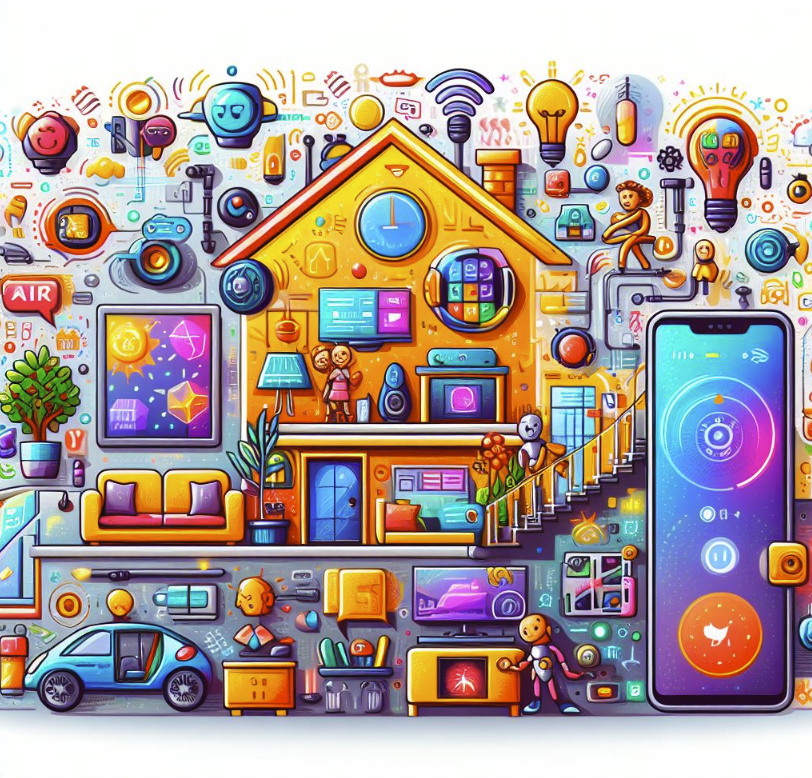The concept of a smart home has gained significant popularity.
With the advancement of technology, homeowners now have the option to transform their traditional houses into smart homes, where various devices and appliances can be controlled remotely and automated to enhance convenience and efficiency.
However, the decision to invest in a smart home comes with its own set of considerations.
Smart Home vs. Non-Smart Home
Smart Home:
- Automation: Enables automation of lights, thermostats, security systems, and more.
- Remote Control: Allows control of various devices remotely via smartphones or voice commands.
- Energy Efficiency: Potential for improved energy efficiency through optimized device control.
- Security: Enhanced security features like smart locks and surveillance systems.
- Cost: Higher initial investment in smart devices and potentially ongoing costs for cloud services.
Non-Smart Home:
- Manual Control: Requires physical interaction for controlling devices and systems.
- Limited Remote Abilities: Lacks the capability for remote control and monitoring of home devices.
- Energy Efficiency: May lack optimization features that smart systems provide.
- Security: Traditional security measures without smart monitoring and alerts.
- Cost: Lower initial investment without the need for purchasing smart devices.
Smart homes offer enhanced control, automation, and potentially improved energy efficiency and security through interconnected devices.
Non-smart homes are typically more straightforward and less expensive in terms of initial setup but lack the convenience and features of smart systems.
Below we look deeper at the benefits and drawbacks of smart homes compared to non-smart homes, helping readers make an informed decision about whether the investment is worth it.
Table of Contents
The Rise of Smart Homes
Smart homes have become increasingly prevalent due to the rapid development of Internet of Things (IoT) technology.
IoT refers to the network of physical devices embedded with sensors, software, and connectivity, enabling them to connect and exchange data.
This technology has paved the way for the creation of smart devices that can be controlled remotely through smartphones or voice assistants.
The global smart home market is nearly a $200 billion industry.
This growth can be attributed to the numerous advantages that smart homes offer, such as increased convenience, energy efficiency, and enhanced security.
The Benefits of Smart Homes
1. Convenience and Control
One of the primary advantages of a smart home is the convenience it provides.
With smart devices, homeowners can control various aspects of their homes remotely.
For example, they can adjust the temperature, turn on/off lights, lock/unlock doors, and even start appliances like washing machines or ovens from anywhere using their smartphones or voice commands.
This level of control allows homeowners to save time and effort by automating routine tasks.
For instance, they can set up schedules for lights to turn on and off automatically, ensuring a well-lit home even when they are away.
Additionally, the ability to control devices remotely provides peace of mind, as homeowners can monitor their homes and receive alerts in case of any security breaches.
2. Energy Efficiency and Cost Savings
Smart homes offer significant energy-saving benefits, which can lead to cost savings in the long run.
By integrating smart thermostats, lighting systems, and appliances, homeowners can optimize energy usage based on their preferences and occupancy patterns.
For instance, smart thermostats can learn the homeowners’ temperature preferences and adjust accordingly, resulting in reduced energy consumption.
Similarly, smart lighting systems can automatically turn off lights in unoccupied rooms, preventing unnecessary energy wastage.
According to a study conducted by the American Council for an Energy-Efficient Economy (ACEEE), smart thermostats alone can save homeowners up to 10-15% on heating and cooling costs.
When combined with other energy-efficient devices, the savings can be even more substantial.
3. Enhanced Security
Security is a top priority for homeowners, and smart homes offer advanced security features that traditional homes lack.
Smart security systems can include features such as surveillance cameras, motion sensors, door/window sensors, and smart locks.
These devices can be integrated into a centralized system that allows homeowners to monitor their homes remotely and receive real-time alerts in case of any suspicious activities.
Some smart security systems even have the capability to notify authorities automatically in emergency situations.
According to a study by the University of North Carolina at Charlotte, homes equipped with smart security systems are less likely to be targeted by burglars.
The study found that 60% of burglars would avoid homes with visible security systems, highlighting the deterrent effect of these devices.
The Drawbacks of Smart Homes
1. Cost of Implementation
One of the main concerns when considering a smart home is the initial cost of implementation.
Smart devices and systems can be more expensive compared to their traditional counterparts.
For example, smart thermostats can cost several times more than regular thermostats.
Additionally, transforming an entire home into a smart home requires an investment in multiple devices, such as smart lighting systems, security systems, and appliances.
The cumulative cost of these devices can be significant, especially for homeowners on a tight budget.
2. Compatibility and Complexity
Another challenge with smart homes is the compatibility and complexity of different devices and systems.
As the market is flooded with various brands and technologies, ensuring seamless integration and compatibility between devices can be a daunting task.
Homeowners may face difficulties in setting up and configuring different devices to work together.
This complexity can be overwhelming for individuals who are not tech-savvy, potentially leading to frustration and dissatisfaction with the smart home experience.
3. Privacy and Security Risks
While smart homes offer enhanced security features, they also introduce new privacy and security risks.
As smart devices collect and exchange data, there is a potential for unauthorized access or data breaches.
For example, hackers may exploit vulnerabilities in smart security systems to gain access to a home’s surveillance cameras or personal information.
Additionally, there have been instances where voice assistants accidentally recorded private conversations and shared them with unintended recipients.
It is crucial for homeowners to take necessary precautions, such as using strong passwords, regularly updating firmware, and choosing reputable brands, to mitigate these risks.
FAQs – Smart Home vs. Non-Smart Home: Is the Investment Worth It?
1. Are smart homes more expensive than non-smart homes?
Smart homes can be more expensive initially due to the cost of smart devices and systems. However, they can lead to long-term cost savings through energy efficiency.
2. Can I control a smart home remotely?
Yes, one of the main advantages of a smart home is the ability to control devices remotely using smartphones or voice assistants.
3. Do smart homes consume more energy?
No, smart homes are designed to optimize energy usage and can actually help reduce energy consumption through features like smart thermostats and lighting systems.
4. Are smart homes more secure than non-smart homes?
Smart homes offer enhanced security features compared to non-smart homes.
However, it is important to take necessary precautions to protect against privacy and security risks.
5. Can I integrate existing devices into a smart home system?
Compatibility can vary depending on the devices and systems. It is advisable to check compatibility before integrating existing devices into a smart home system.
6. Can smart homes be hacked?
While there is a potential for unauthorized access or data breaches, taking necessary precautions such as using strong passwords and regularly updating firmware can mitigate the risk of hacking.
7. Do smart homes require a stable internet connection?
Yes, a stable internet connection is necessary for smart devices to communicate with each other and for remote control functionality.
8. Can I install smart devices in a rented home?
It depends on the terms of the rental agreement and the willingness of the landlord.
It is advisable to seek permission before installing smart devices in a rented home.
9. Can smart homes increase the value of a property?
Smart home features can potentially increase the value of a property, as they are increasingly sought after by homebuyers.
However, the extent of the impact may vary depending on the market and location.
10. Are smart homes suitable for elderly individuals?
Smart homes can offer convenience and safety features that are beneficial for elderly individuals.
For example, remote control of devices and automated lighting can make daily tasks easier.
11. Can I customize the automation settings in a smart home?
Yes, smart homes allow homeowners to customize automation settings based on their preferences and routines.
12. Do smart homes require professional installation?
While some devices may require professional installation, many smart devices can be easily installed by homeowners themselves.
13. Can smart homes be controlled without a smartphone?
Yes, smart homes can also be controlled using voice assistants like Amazon Alexa or Google Assistant.
14. Are there any health risks associated with smart homes?
There are no significant health risks associated with smart homes.
However, individuals sensitive to electromagnetic fields may want to consider the potential exposure from smart devices.
15. Can I start with a few smart devices and expand later?
Yes, homeowners can start with a few smart devices and gradually expand their smart home system over time.
Summary – Smart Home vs. Non-Smart Home: Is the Investment Worth It?
Smart homes offer numerous benefits, including convenience, energy efficiency, and enhanced security.
The ability to control devices remotely and automate routine tasks provides homeowners with convenience and peace of mind.
Energy-efficient features can lead to cost savings in the long run, while advanced security systems deter potential burglars.
However, there are also drawbacks to consider.
The initial cost of implementing a smart home can be high, and ensuring compatibility between different devices can be complex.
Privacy and security risks associated with smart devices also need to be addressed.
Ultimately, the decision to invest in a smart home depends on individual preferences, budget, and willingness to embrace new technology.
It is essential for homeowners to carefully weigh the benefits and drawbacks before making a decision.


